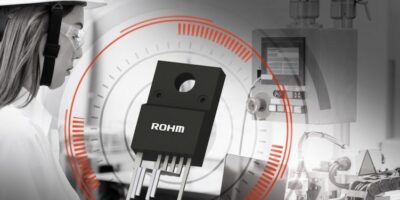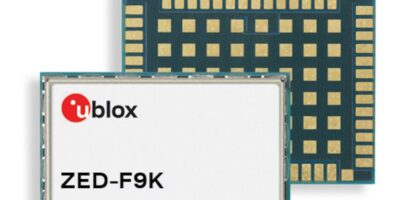ROHM recently announced the availability of AC/DC converter ICs with a built-in 1700V SiC MOSFET, the BM2SCQ12xT-LBZ series. This series is optimised for industrial applications including street lamps, commercial AC systems, and general-purpose AC servos and inverters used in high power equipment.
SiC power semiconductors deliver greater power efficiency, miniaturisation, and higher voltage capability than the existing Si power devices. In recent years, the growing demand for energy savings has resulted in the adoption of power semiconductors such as SiC in 400VAC industrial applications. On the other hand, industrial equipment consists of the main power supply circuit and a built-in auxiliary power supply that supplies power to various control systems. The use of low voltage Si-MOSFETS and IGBTs limits the amount of power savings in auxiliary power supply.
In response, ROHM has strived to lead the development of ICs that maximise the performance of SiC power semiconductors. In 2015, the company became the first to offer AC/DC converter ICs for driving high voltage, low-loss SiC MOSFETs. This time, we created the industry’s first AC/DC converter ICs with a built-in SiC MOSFET that will further accelerate the adoption of AC/DC converters that use SiC MOSFETs in industrial equipment.
Furthermore, the BM2SCQ12xT-LBZ series integrate 1700V SiC MOSFET, which is also an industry first. This series enables breakthrough energy savings and facilitates efficient AC/DC converter design by resolving many of the issues encountered by designers using discrete solutions. Incorporating a SiC MOSFET and control circuitry optimised for auxiliary power supplies for industrial equipment in a single package significantly reduces the number of parts required when compared to the conventional designs (from 12pcs plus heat sink to a single IC). It also aids to minimizing both the component failure risk and the amount of resources required to develop systems using SiC MOSFETs. In addition, this product enables the improvement of power efficiency by 5% (and decreasing power loss by 28%). These features translate to dramatic reduction in size, improved reliability, and superior power savings in industrial applications.
ROHM is committed to developing not only power semiconductors such as SiC devices but also the ICs for controlling them, and to providing optimised solutions that contribute to greater energy savings and performance in industrial equipment.
Key Features
The BM2SCQ12xT-LBZ series adopts a dedicated package that incorporates a 1700V SiC MOSFET along with the control circuitry (i.e. SiC MOSFET gate drive circuit) optimised for industrial auxiliary power supplies.
These leading technology AC/DC converter ICs deliver advantages that contribute to increase the demand of AC/DC converters with integrated SiC MOSFETs by improving the reliability, energy efficiency, and compactness of 400VAC industrial equipment.
1. Breakthrough miniaturisation is enabled by replacing 12 components and heat sink with a single package
ROHM’s latest products replace up to 12 components (AC/DC converter IC, 800V Si MOSFET x 2, Zener diode x 3, resistor x 6) and the heat sink with a single package, dramatically reducing the number of external parts required. In addition, the high withstand voltage and voltage noise resistance of the internal SiC MOSFET make it possible to reduce the size of components used for noise suppression.
2. Development resources and design risks are reduced while providing multiple built-in protection functions that enable superior reliability
The monolithic design reduces the resources required for component selection and reliability evaluation for the clamp and drive circuits while also minimising component failure risk and simplifying the development effort for SiC MOSFET adoption. In addition, overload protection (FB OLP), overvoltage protection (VCC OVP) of the supply voltage pin, and a high accuracy thermal shutdown function (TSD) (achieved through the built-in SiC MOSFETs) are built in, along with the over current protection and secondary overvoltage protection functions. This enables the incorporation of multiple protection circuits for industrial power supplies that require continuous operation hence leading to a significant improvement in system reliability.
3. SiC MOSFET performance is optimised to achieve dramatically improved power savings
Both internal SiC MOSFET and the built-in gate driver circuit optimised for this SiC MOSFET improve efficiency by as much as 5% over conventional Si MOSFETs (ROHM April 2018 study). Also, a quasi-resonant method is adopted for the control circuit that enables operation at higher efficiency and lower noise than conventional PWM systems, minimising the effects of noise in industrial equipment.
(fig. 14
SiC MOSFET Advantages
SiC MOSFETs provide a number of advantages over their silicon counterparts in the high breakdown voltage region, such as lower switching and conduction losses, higher power handling capability, and a high temperature capability. This reduces the number of parts required and PCB area while improving energy savings when used in AC/DC and DC/DC converters.
Availability: Now (samples), May 2019 (OEM quantities).
Additionally, evaluation boards will be released later this year.
About ROHM Semiconductor
For further information please contact www.rohm.com/eu







